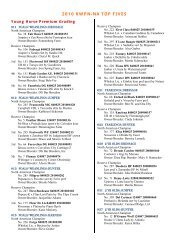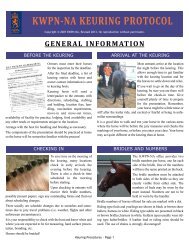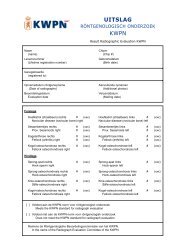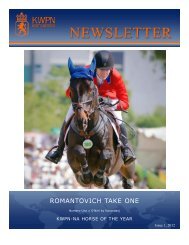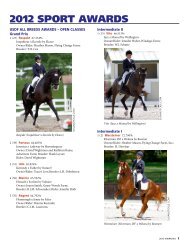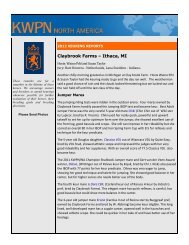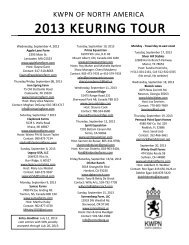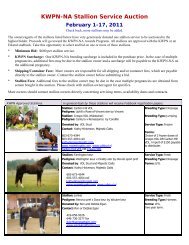Download PDF - KWPN
Download PDF - KWPN
Download PDF - KWPN
You also want an ePaper? Increase the reach of your titles
YUMPU automatically turns print PDFs into web optimized ePapers that Google loves.
KEURING - PREPARING YOUR HORSE<br />
The following contains some<br />
general guidelines to keep<br />
in mind when preparing a<br />
horse for the keuring.<br />
by Willy Arts<br />
It’s that time of the year again. We<br />
have all received our keuring entry<br />
form and are excited about our new<br />
foal crops and getting the horses ready<br />
for the keuring. I’d like to give you<br />
some guidelines on how to select a<br />
horse to take to the keuring and how to<br />
prepare them for each class. I think we<br />
should divide this into three: young<br />
horses (foals through two-year olds),<br />
horses three and older, and the under<br />
saddle classes, which we’ll split up into<br />
the DG Bar Cup for dressage and the<br />
Iron Spring Farm Cup for jumping.<br />
Foals, yearlings and two<br />
year olds<br />
Foals<br />
Foals always make up one of the<br />
most exciting groups because everybody<br />
wants to compare their own new<br />
foals to other people’s foals. It’s also<br />
exciting to see the first foals from a<br />
new and up-and-coming stallion or<br />
mare.<br />
I think the foal group is one of the<br />
easiest groups to prepare. You have to<br />
make sure your foal is well halter<br />
broke and handled. A foal can be<br />
turned free next to the mare. At DG<br />
Bar we have a ring where the mare is<br />
trotted on the outside of the fence and<br />
the foals are in the inside. This is nice<br />
because the foal can not go behind the<br />
mare or jump on her and so they show<br />
really well. If anyone would like information<br />
on how set it up you can let me<br />
know. Weaned foals need to be shown<br />
in hand which is hard to do. Also<br />
weaned foals are harder to keep in<br />
Newsletter • Page 4<br />
good condition compared to the ones<br />
shown at the side of the mare. It is also<br />
much easier on the foals if they can<br />
travel to the keuring with their dams<br />
versus going by themselves.<br />
It is very important to keep an eye<br />
on your foal’s condition so you don’t<br />
have to make drastic changes in your<br />
feeding program. Drastic changes are<br />
not good for young growing horses,<br />
they can create permanent problems.<br />
Sometimes you see weaned foals with<br />
big stomachs; this is usually a sign of<br />
a worming problem. Foals should be<br />
in such a condition that you can’t see<br />
their ribs and they should have a nice<br />
hair coat. There are times you can’t get<br />
enough weight on a foal and then you<br />
might think about crib feeding it.<br />
Other times a foal may be too fat and<br />
you just can’t get the weight off. In<br />
that case - as long as the foal is about<br />
four months old or older - you can take<br />
it away from the mare for 4 to 5 hours<br />
a day (either at one time or split in two<br />
sessions). The separation will decrease<br />
the mare’s milk production and should<br />
cause the foal to loose some weight.<br />
During the times that the foal is away<br />
from the mare you can work with it on<br />
braiding, standing, leading, etc.<br />
Braiding looks nice but sometimes,<br />
when the neck is not muscled very<br />
well, pulling the mane looks even better.<br />
You can clip the ears, nose, legs,<br />
etc., but the most important thing is<br />
that your foal is in good condition.<br />
Yearlings and two year olds<br />
Yearlings and two-year olds are<br />
young and growing horses and it is<br />
actually advisable to leave them in the<br />
pasture and let them grow up. But if<br />
you live in an area where there is no<br />
regular keuring it is understandable<br />
that you’d like an evaluation from the<br />
jury about your horse. Again, start<br />
looking at his or her condition early so<br />
that if you need to make adjustments<br />
in the feed they will be small adjustments.<br />
Something that helps a great<br />
deal is to walk your horse in-hand four<br />
to five times a week, up to about half<br />
an hour of a nice crisp walk. You will<br />
be amazed at how this improves the<br />
muscling of the topline.<br />
When preparing these youngsters<br />
keep in mind they should definitely<br />
not be lunged when they are too fresh.<br />
If they are too fresh, turn them out and<br />
let them play free. Afterward they will<br />
be much easier to handle. If you practice<br />
running in-hand with them, make<br />
sure that you, or whoever is doing the<br />
running, can keep up with the horse.<br />
Also when you run them in-hand,<br />
always make sure they are straight so<br />
that they can use their neck freely and<br />
stay balanced<br />
Teach them the basic commands:<br />
walk, trot, canter and whoa. For example,<br />
to teach them a voice command to<br />
go forward you give the command or<br />
sign, and at the same moment a person<br />
behind the horse immediately encourages<br />
the horse to go forward with a<br />
whip. The horse will remember your<br />
command and will listen to it in the<br />
show ring when you repeat that same<br />
command.<br />
Three and four year olds<br />
This is a very important time in the<br />
horse’s life. At the studbook inspection





